Nissan Maxima Service and Repair Manual: Diagnosis system (ECM)
DIAGNOSIS DESCRIPTION
DIAGNOSIS DESCRIPTION : 1st Trip Detection Logic and Two Trip Detection Logic
When a malfunction is detected for the first time, 1st trip DTC and 1st trip Freeze Frame data are stored in the ECM memory. The MIL will not illuminate at this stage. <1st trip> If the same malfunction is detected again during the next drive, the DTC and Freeze Frame data are stored in the ECM memory, and the MIL illuminates. The MIL illuminates at the same time when the DTC is stored.
<2nd trip> The "trip" in the "Two Trip Detection Logic" means a driving mode in which self-diagnosis is performed during vehicle operation. Specific on board diagnostic items will cause the ECM to illuminate or blink the MIL, and store DTC and Freeze Frame data, even in the 1st trip, as shown below.
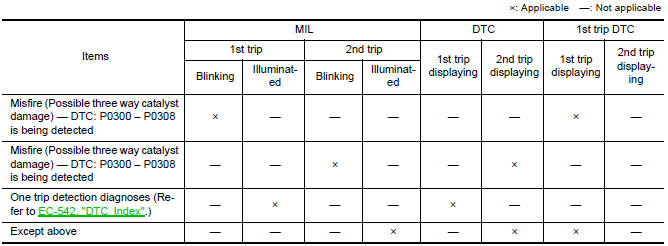
DIAGNOSIS DESCRIPTION : DTC and Freeze Frame Data
DTC AND 1ST TRIP DTC
The 1st trip DTC (whose number is the same as the DTC number) is displayed for the latest self-diagnostic result obtained. If the ECM memory was cleared previously, and the 1st trip DTC did not recur, the 1st trip DTC will not be displayed.
If a malfunction is detected during the 1st trip, the 1st trip DTC is saved in the ECM memory. The MIL will not light up (two trip detection logic). If the same malfunction is not detected in the 2nd trip (meeting the required driving pattern), the 1st trip DTC is cleared from the ECM memory. If the same malfunction is detected in the 2nd trip, both the 1st trip DTC and DTC are saved in the ECM memory and the MIL lights up. In other words, the DTC is stored in the ECM memory and the MIL lights up when the same malfunction occurs in two consecutive trips. If a 1st trip DTC is stored and a non-diagnostic operation is performed between the 1st and 2nd trips, only the 1st trip DTC will continue to be stored. For malfunctions that blink or light up the MIL during the 1st trip, the DTC and 1st trip DTC are stored in the ECM memory.
For malfunctions in which 1st trip DTCs are displayed, refer to EC-542, "DTC Index". These items are required by legal regulations to continuously monitor the system/component. In addition, the items monitored non-continuously are also displayed on CONSULT.
1st trip DTC is specified in Service $07 of SAE J1979/ISO 15031-5. 1st trip DTC detection occurs without illuminating the MIL and therefore does not warn the driver of a malfunction.
When a 1st trip DTC is detected, check, print out or write down and erase (1st trip) DTC and Freeze Frame data as specified in Work Flow procedure Step 2, refer to EC-9, "Work Flow". Then perform DTC Confirmation Procedure or Component Function Check to try to duplicate the malfunction. If the malfunction is duplicated, the item requires repair.
FREEZE FRAME DATA AND 1ST TRIP FREEZE FRAME DATA
The ECM records the driving conditions such as fuel system status, calculated load value, engine coolant temperature, short term fuel trim, long term fuel trim, engine speed, vehicle speed, absolute throttle position, base fuel schedule and intake air temperature at the moment a malfunction is detected.
Data which are stored in the ECM memory, along with the 1st trip DTC, are called 1st trip freeze frame data.
The data, stored together with the DTC data, are called freeze frame data and displayed on CONSULT or GST. The 1st trip freeze frame data can only be displayed on the CONSULT screen.
Only one set of freeze frame data (either 1st trip freeze frame data or freeze frame data) can be stored in the ECM. 1st trip freeze frame data is stored in the ECM memory along with the 1st trip DTC. There is no priority for 1st trip freeze frame data and it is updated each time a different 1st trip DTC is detected. However, once freeze frame data (2nd trip detection/MIL on) is stored in the ECM memory, 1st trip freeze frame data is no longer stored. Remember, only one set of freeze frame data can be stored in the ECM. The ECM has the following priorities to update the data

For example, the EGR malfunction (Priority: 2) was detected and the freeze frame data was saved in the 2nd trip. After that when the misfire (Priority: 1) is detected in another trip, the freeze frame data will be updated from the EGR malfunction to the misfire. The 1st trip freeze frame data is updated each time a different malfunction is detected. There is no priority for 1st trip freeze frame data. However, once freeze frame data is stored in the ECM memory, 1st trip freeze data is no longer stored (because only one freeze frame data or 1st trip freeze frame data can be stored in the ECM). If freeze frame data is stored in the ECM memory and freeze frame data with the same priority occurs later, the first (original) freeze frame data remains unchanged in the ECM memory.
Both 1st trip freeze frame data and freeze frame data (along with the DTCs) are cleared when the ECM memory is erased.
DIAGNOSIS DESCRIPTION : Counter System
RELATIONSHIP BETWEEN MIL, 1ST TRIP DTC, DTC, AND DETECTABLE ITEMS
- When a malfunction is detected for the first time, the 1st trip DTC and the 1st trip freeze frame data are stored in the ECM memory.
- When the same malfunction is detected in two consecutive trips, the DTC and the freeze frame data are stored in the ECM memory, and the MIL will come on.
- The MIL will turn OFF after the vehicle is driven 3 times (driving pattern B) with no malfunction. The drive is counted only when the recorded driving pattern is met (as stored in the ECM). If another malfunction occurs while counting, the counter will reset.
- The DTC and the freeze frame data will be stored until the vehicle is driven 40 times (driving pattern A) without the same malfunction recurring (except for Misfire and Fuel Injection System). For Misfire and Fuel Injection System, the DTC and freeze frame data will be stored until the vehicle is driven 80 times (driving pattern C) without the same malfunction recurring. The "TIME" in "SELF-DIAGNOSTIC RESULTS" mode of CONSULT will count the number of times the vehicle is driven.
- The 1st trip DTC is not displayed when the self-diagnosis results in OK for the 2nd trip.
COUNTER SYSTEM CHART

For details about patterns B and C under "Fuel Injection System" and "Misfire", see "EXPLANATION FOR DRIVING PATTERNS FOR "MISFIRE <EXHAUST QUALITY DETERIORATION>", "FUEL INJECTION SYSTEM".
For details about patterns A and B under Other, see "EXPLANATION FOR DRIVING PATTERNS FOR "MISFIRE <EXHAUST QUALITY DETERIORATION>", "FUEL INJECTION SYSTEM".
- *1: Clear timing is at the moment OK is detected.
- *2: Clear timing is when the same malfunction is detected in the 2nd trip.
Relationship Between MIL, DTC, 1st Trip DTC and Driving Patterns for "Misfire <Exhaust Quality Deterioration>", "Fuel Injection System"
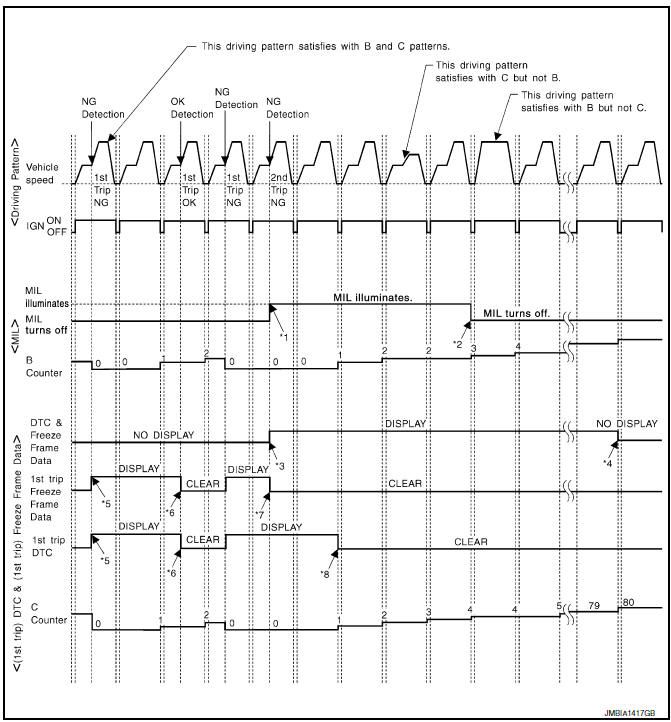
*1: When the same malfunction is detected
in two consecutive trips, MIL
will light up.
*2: MIL will turn OFF after vehicle is driven
3 times (pattern B) without any
malfunctions..
*3: When the same malfunction is detected
in two consecutive trips, the
DTC and the freeze frame data will be
stored in ECM..
*4: The DTC and the freeze frame data
will not be displayed any longer after
vehicle is driven 80 times (pattern C)
without the same malfunction. (The
DTC and the freeze frame data still
remain in ECM.).
*5: When a malfunction is detected for
the first time, the 1st trip DTC and the
1st trip freeze frame data will be
stored in ECM..
*6: The 1st trip DTC and the 1st trip
freeze frame data will be cleared at
the moment OK is detected..
*7: When the same malfunction is detected
in the 2nd trip, the 1st trip
freeze frame data will be cleared..
*8: 1st trip DTC will be cleared when vehicle
is driven once (pattern C) without
the same malfunction after DTC
is stored in ECM.
Explanation for Driving Patterns for "Misfire <Exhaust Quality Deterioration>", "Fuel Injection System"
Driving Pattern B
Driving Pattern C
Example: If the stored freeze frame data is as per the following: Engine speed: 850 rpm, Calculated load value: 30%, Engine coolant temperature: 80C (176F) To be satisfied with driving pattern C, the vehicle should run under the following conditions: Engine speed: 475 - 1,225 rpm, Calculated load value: 27 - 33%, Engine coolant temperature: more than 70C (158F)
Relationship Between MIL, DTC, 1st Trip DTC and Driving Patterns Except For "Misfire <Exhaust Quality Deterioration>", "Fuel Injection System"
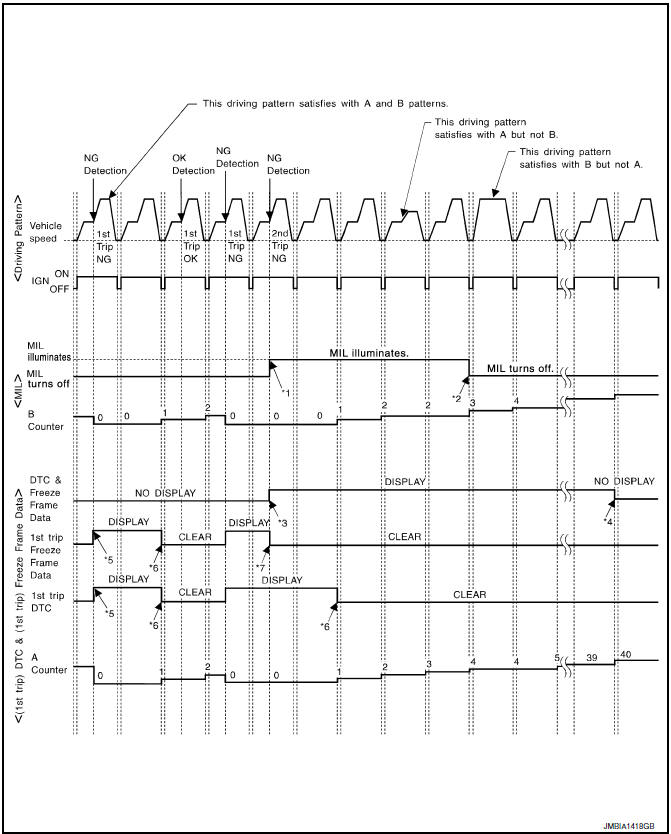
*1: When the same malfunction is detected
in two consecutive trips, MIL
will light up.
*2: MIL will turn OFF after vehicle is driven
3 times (pattern B) without any
malfunctions.
*3: When the same malfunction is detected
in two consecutive trips, the
DTC and the freeze frame data will be
stored in ECM.
*4: The DTC and the freeze frame data
will not be displayed any longer after
vehicle is driven 40 times (pattern A)
without the same malfunction.
(The DTC and the freeze frame data
still remain in ECM.)
*5: When a malfunction is detected for
the first time, the 1st trip DTC and the
1st trip freeze frame data will be
stored in ECM.
*6: 1st trip DTC will be cleared after vehicle
is driven once (pattern B) without
the same malfunction.
*7: When the same malfunction is detected
in the 2nd trip, the 1st trip
freeze frame data will be cleared.
Explanation for Driving Patterns Except for "Misfire <Exhaust Quality Deterioration>", "Fuel Injection System"
Driving Pattern A
Driving Pattern B
DIAGNOSIS DESCRIPTION : Driving Pattern
CAUTION: Always drive at a safe speed.
DRIVING PATTERN A
Driving pattern A means a trip satisfying the following conditions.
- Engine speed reaches 400 rpm or more.
- Engine coolant temperature rises by 20C (36F) or more after starting the engine.
- Engine coolant temperature reaches 70C (158F) or more.
- The ignition switch is turned from ON to OFF.
NOTE:
- When the same malfunction is detected regardless of driving conditions, reset the counter of driving pattern A.
- When the above conditions are satisfied without detecting the same malfunction, reset the counter of driving pattern A.
DRIVING PATTERN B
Driving pattern B means a trip satisfying the following conditions.
- Engine speed reaches 400 rpm or more.
- Engine coolant temperature reaches 70C (158F) or more.
- Vehicle speed of 70 - 120 km/h (44 - 75 MPH) is maintained for 60 seconds or more under the control of closed loop.
- Vehicle speed of 30 - 60 km/h (19 - 37 MPH) is maintained for 10 seconds or more under the control of closed loop.
- Under the closed loop control condition, the following state reaches 12 seconds or more in total: Vehicle speed of 4 km/h (2 MPH) or less with idling condition.
- The state of driving at 10 km/h (7 MPH) or more reaches 10 minutes or more in total.
- A lapse of 22 minutes or more after engine start.
NOTE:
- Drive the vehicle at a constant velocity.
- When the same malfunction is detected regardless of driving conditions, reset the counter of driving pattern B.
- When the above conditions are satisfied without detecting the same malfunction, reset the counter of driving pattern B.
DRIVING PATTERN C
Driving pattern C means operating vehicle as per the following: The following conditions should be satisfied at the same time: Engine speed: (Engine speed in the freeze frame data) +-375 rpm
Calculated load value: (Calculated load value in the freeze frame data) x (1+-0.1) [%] Engine coolant temperature condition:
- When the freeze frame data shows lower than 70C (158F), engine coolant temperature should be lower than 70C (158F).
- When the freeze frame data shows higher than or equal to 70C (158F), engine coolant temperature should be higher than or equal to 70C (158F).
NOTE:
- When the same malfunction is detected regardless of the above vehicle conditions, reset the counter of driving pattern C.
- When the above conditions are satisfied without detecting the same malfunction, reset the counter of driving pattern C.
- The 1st trip DTC will be cleared when C counter is counted once without the same malfunction after DTC is stored in ECM.
DIAGNOSIS DESCRIPTION : System Readiness Test (SRT) Code
System Readiness Test (SRT) code is specified in Service $01 of SAE J1979/ISO 15031-5.
As part of an enhanced emissions test for Inspection & Maintenance (I/M), certain states require the status of SRT be used to indicate whether the ECM has completed self-diagnosis of major emission systems and components.
Completion must be verified in order for the emissions inspection to proceed.
If a vehicle is rejected for a State emissions inspection due to one or more SRT items indicating "INCMP", use the information in this Service Manual to set the SRT to "CMPLT".
In most cases the ECM will automatically complete its self-diagnosis cycle during normal usage, and the SRT status will indicate "CMPLT" for each application system. Once set as "CMPLT", the SRT status remains "CMPLT" until the self-diagnosis memory is erased.
Occasionally, certain portions of the self-diagnostic test may not be completed as a result of the customer's normal driving pattern; the SRT will indicate "INCMP" for these items. NOTE: The SRT will also indicate "INCMP" if the self-diagnosis memory is erased for any reason or if the ECM memory power supply is interrupted for several hours.
If, during the state emissions inspection, the SRT indicates "CMPLT" for all test items, the inspector will continue with the emissions test. However, if the SRT indicates "INCMP" for one or more of the SRT items the vehicle is returned to the customer untested.
NOTE: If permanent DTC is stored or MIL illuminates during the state emissions inspection, the vehicle is also returned to the customer untested even though the SRT indicates "CMPLT" for all test items. Therefore, it is important to check SRT ("CMPLT"), DTC (No DTCs) and permanent DTC (NO permanent DTCs) before the inspection.
SRT SET TIMING
SRT is set as "CMPLT" after self-diagnosis has been performed one or more times. Completion of SRT is done regardless of whether the result is OK or NG. The set timing is different between OK and NG results and is shown in the table below.
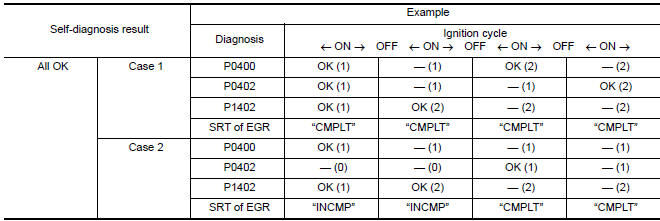

OK: Self-diagnosis is carried out and the result is OK.
NG: Self-diagnosis is carried out and the result is NG.
-: Self-diagnosis is not carried out.
When all SRT related self-diagnoses show OK results in a single cycle (Ignition OFF-ON-OFF), the SRT will indicate "CMPLT". → Case 1 above When all SRT related self-diagnoses show OK results through several different cycles, the SRT will indicate "CMPLT" at the time the respective self-diagnoses have at least one OK result. → Case 2 above If one or more SRT related self-diagnoses show NG results in 2 consecutive cycles, the SRT will also indicate "CMPLT". → Case 3 above The table above shows that the minimum number of cycles for setting SRT as "INCMP" is the number one (1) for each self-diagnosis (Case 1 & 2) or the number two (2) for one of self-diagnoses (Case 3). However, in preparation for the state emissions inspection, it is unnecessary for each self-diagnosis to be executed twice (Case 3) for the following reasons:
- The SRT will indicate "CMPLT" at the time the respective self-diagnoses have one (1) OK result.
- The emissions inspection requires "CMPLT" of the SRT only with OK self-diagnosis results.
- During SRT driving pattern, the 1st trip DTC (NG) is detected prior to "CMPLT" of SRT and the self-diagnosis memory must be erased from the ECM after repair.
- If the 1st trip DTC is erased, all the SRT will indicate "INCMP".
NOTE: SRT can be set as "CMPLT" together with the DTC(s). Therefore, DTC check must always be carried out prior to the state emission inspection even though the SRT indicates "CMPLT".
DIAGNOSIS DESCRIPTION : Permanent Diagnostic Trouble Code (Permanent DTC)
Permanent DTC is defined in SAE J1979/ISO 15031-5 Service $0A.
ECM stores a DTC issuing a command of turning on MIL as a permanent DTC and keeps storing the DTC as a permanent DTC until ECM judges that there is no presence of malfunction.
Permanent DTCs cannot be erased by using the Erase function of CONSULT or Generic Scan Tool (GST) and by disconnecting the battery to shut off power to ECM. This prevents a vehicle from passing the state emission inspection without repairing a malfunctioning part.
When not passing the state emission inspection due to more than one permanent DTC, permanent DTCs should be erased, referring to this manual.
NOTE:
- The important items in state emission inspection are that MIL is not ON, SRT test items are set, and permanent DTCs are not included.
- Permanent DTCs do not apply for regions that permanent DTCs are not regulated by law.
PERMANENT DTC SET TIMING
The setting timing of permanent DTC is stored in ECM with the lighting of MIL when a DTC is confirmed.
DIAGNOSIS DESCRIPTION : Malfunction Indicator Lamp (MIL)
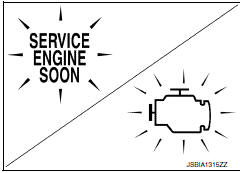
When emission-related ECU detects a malfunction in the emission control systems components and/or the powertrain control components (which affect vehicle emissions), it turns on/blinks MIL to inform the driver that a malfunction has been detected.
- The MIL illuminates when ignition switch is turned ON (engine is not running). NOTE: Check the MIL circuit if MIL does not illuminate. Refer to EC- 507, "Component Function Check".
- When the engine is started, the MIL should go off. NOTE: If MIL continues to illuminate/blink, perform self-diagnoses and inspect/repair accordingly because an emission-related ECU has detected a malfunction in the emission control systems components and/or the powertrain control components (which affect vehicle emissions).
On Board Diagnosis Function
ON BOARD DIAGNOSIS ITEM
The on board diagnostic system has the following functions.
|
Diagnostic test mode |
Function |
| Bulb check | MIL can be checked |
| SRT status | ECM can read if SRT codes are set |
| Malfunction warning | If ECM detects a malfunction, it illuminates or blinks MIL to inform the driver that a malfunction has been detected |
| Self-diagnostic results | DTCs or 1st trip DTCs stored in ECM can be read. |
| Accelerator pedal released position learning | ECM can learn the accelerator pedal released position |
| Throttle valve closed position learning | ECM can learn the throttle valve closed position. |
| Idle air volume learning | ECM can learn the idle air volume |
| Mixture ratio self-learning value clear | Mixture ratio self-learning value can be erased |
BULB CHECK MODE
Description
This function allows damage inspection in the MIL bulb (blown, open circuit, etc.).
Operation Procedure
- Turn ignition switch ON.
- The MIL on the instrument panel should stay ON.
If it remains OFF, check MIL circuit. Refer to EC-507, "Diagnosis Procedure".
SRT STATUS MODE
Description
This function allows to read if ECM has completed the self-diagnoses of major emission control systems and components. For SRT, refer to EC-133, "DIAGNOSIS DESCRIPTION : System Readiness Test (SRT) Code".
Operation Procedure
- Turn ignition switch ON and wait 20 seconds.
- SRT status is indicated as shown blow.
- ECM continues to illuminate MIL if all SRT codes are set.
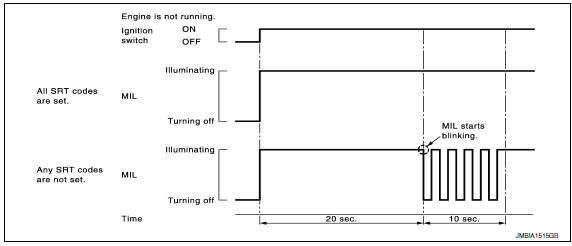
MALFUNCTION WARNING MODE
Description
In this function ECM turns on or blinks MIL when it detects a malfunction in the emission control system components and/or the powertrain control components (which affect vehicle emissions) to inform the driver that a malfunction has been detected.
Operation Procedure
- Turn ignition switch ON.
- Check that MIL illuminates.
If it remains OFF, check MIL circuit. Refer to EC-507, "Diagnosis Procedure".
- Start engine and let it idle.
- For two trip detection logic diagnoses, ECM turns on MIL when it detects the same malfunction twice in the two consecutive driving cycles.
- For 1st trip detection logic diagnoses, ECM turns on MIL when it detects a malfunction in one driving cycle.
- ECM blinks MIL when it detects a malfunction that may damage the three way catalyst (misfire).
SELF-DIAGNOSTIC RESULTS MODE
Description
This function allows to indicate DTCs or 1st trip DTCs stored in ECM according to the number of times MIL is blinking.
How to Set Self-diagnostic Results Mode
NOTE:
- It is better to count the time accurately with a clock.
- It is impossible to switch the diagnostic mode when an accelerator pedal position sensor circuit has a malfunction.
- After ignition switch is turned off, ECM is always released from the "self-diagnostic results" mode.
- Confirm that accelerator pedal is fully released, turn ignition switch ON and wait 3 seconds.
- Repeat the following procedure quickly five times within 5 seconds.
- Fully depress the accelerator pedal.
- Fully release the accelerator pedal.
- Wait 7 seconds, fully depress the accelerator pedal and keep it depressed for approx. 10 seconds until the MIL starts blinking. NOTE: Do not release the accelerator pedal for 10 seconds if MIL starts blinking during this period. This blinking is displaying SRT status and is continued for another 10 seconds.
- Fully release the accelerator pedal.
ECM has entered to "Self-diagnostic results" mode.
NOTE: Wait until the same DTC (or 1st trip DTC) appears to completely confirm all DTCs.

How to Read Self-diagnostic Results
The DTC and 1st trip DTC are indicated by the number of blinks of the MIL as shown below.
The DTC and 1st trip DTC are displayed at the same time. If the MIL does not illuminate in diagnostic test mode I (Malfunction warning), all displayed items are 1st trip DTCs. If only one code is displayed when the MIL illuminates in "malfunction warning" mode, it is a DTC; if two or more codes are displayed, they may be either DTCs or 1st trip DTCs. DTC No. is same as that of 1st trip DTC. These unidentified codes can be identified by using the CONSULT or GST. A DTC will be used as an example for how to read a code.
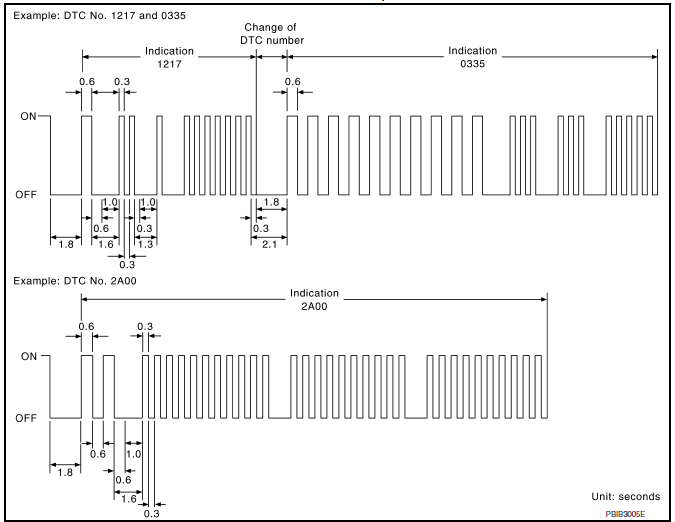
A particular trouble code can be identified by the number of four-digit numeral flashes per the following.

The length of time the 1,000th-digit numeral flashes on and off is 1.2 seconds consisting of an ON (0.6-seconds) - OFF (0.6-seconds) cycle.
The 100th-digit numeral and lower digit numerals consist of a 0.3-seconds ON and 0.3-seconds OFF cycle.
A change from one digit numeral to another occurs at an interval of 1.0-second OFF. In other words, the later numeral appears on the display 1.3 seconds after the former numeral has disappeared.
A change from one trouble code to another occurs at an interval of 1.8-seconds OFF.
In this way, all the detected malfunctions are classified by their DTC numbers. The DTC 0000 refers to no malfunction.
How to Erase Self-diagnostic Results
By performing this procedure, ECM memory is erased and the following diagnostic information is erased as well.
- Diagnostic trouble codes
- 1st trip diagnostic trouble codes
- Freeze frame data
- 1st trip freeze frame data
- System readiness test (SRT) codes
- Test values
NOTE: Also, if a battery terminal is disconnected, ECM memory is erased and the diagnostic information as listed above is erased. (The amount of time required for erasing may vary from a few seconds to several hours.)
- Turn ignition switch OFF and wait at least 10 seconds.
- Turn ignition switch ON.
- Turn ignition switch OFF and wait at least 10 seconds.
- Turn ignition switch ON.
- Set ECM in "self-diagnostic results" mode.
- The diagnostic information has been erased from the backup memory
in the ECM.
Fully depress the accelerator pedal and keep it depressed for more than 10 seconds.
- Fully release the accelerator pedal, and confirm the DTC 0000 is displayed.
CONSULT Function
FUNCTION
|
Diagnostic test mode |
Function |
| Self Diagnostic Result | Self-diagnostic results such as 1st trip DTC, DTCs and 1st trip freeze frame data or freeze frame data can be read and erased quickly.* |
| Data Monitor | Input/Output data in the ECM can be read |
| Work support | This mode enables a technician to adjust some devices faster and more accurately by following the indications on the CONSULT unit |
| Active Test | Diagnostic Test Mode in which CONSULT drives some actuators apart from the ECMs and also shifts some parameters in a specified range. |
| ECU Identification | ECM part number can be read |
| DTC Work Support | The status of system monitoring tests and the self-diagnosis status/results can be confirmed |
*: The following emission-related diagnostic information is cleared when the ECM memory is erased.
- Diagnostic trouble codes
- 1st trip diagnostic trouble codes
- Freeze frame data
- 1st trip freeze frame data
- System readiness test (SRT) codes
- Test values
SELF DIAGNOSTIC RESULT MODE
Self Diagnostic Item
Regarding items of DTC and 1st trip DTC, refer to EC-542, "DTC Index".
How to Read DTC and 1st Trip DTC
DTCs and 1st trip DTCs related to the malfunction are displayed in "self-diag results".
- When ECM detects a 1st trip DTC, 1t" is displayed for "TIME".
- When ECM has detected a current DTC, "0" is displayed for "TIME".
- If "TIME" is neither "0" nor "1t", the DTC occurred in the past and ECM shows the number of times the vehicle has been driven since the last detection of the DTC.
How to Erase DTC and 1st Trip DTC
- If the ignition switch stays ON after repair work, be sure to turn ignition switch OFF once. Wait at least 10 seconds and then turn it ON (engine stopped) again.
- If the DTC is not for A/T related items (see EC-542, "DTC Index"), skip step 1.
- Erase DTC in TCM. Refer to EC-542, "DTC Index".
- Select "ENGINE" with CONSULT.
- Select "SELF-DIAG RESULTS".
- Touch "ERASE". (DTC in ECM will be erased.)
Freeze Frame Data and 1st Trip Freeze Frame Data
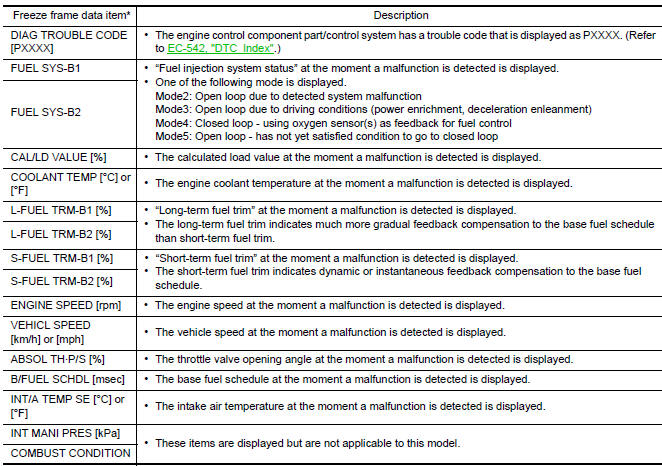
*: The items are the same as those of 1st trip freeze frame data.
DATA MONITOR MODE
NOTE: The following table includes information (items) inapplicable to this vehicle. For information (items) applicable to this vehicle, refer to CONSULT display items.
Monitored Item
For reference values of the following items

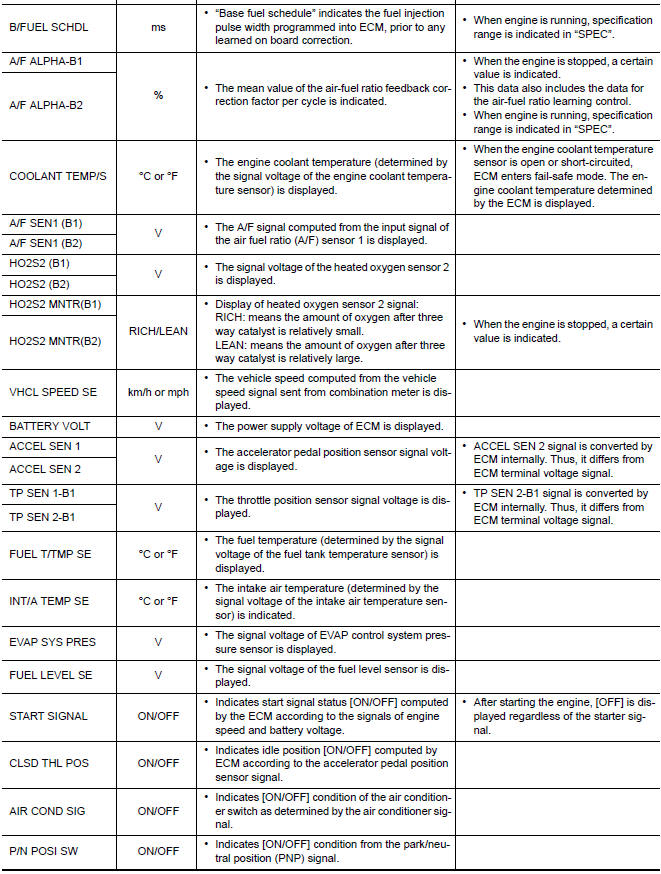
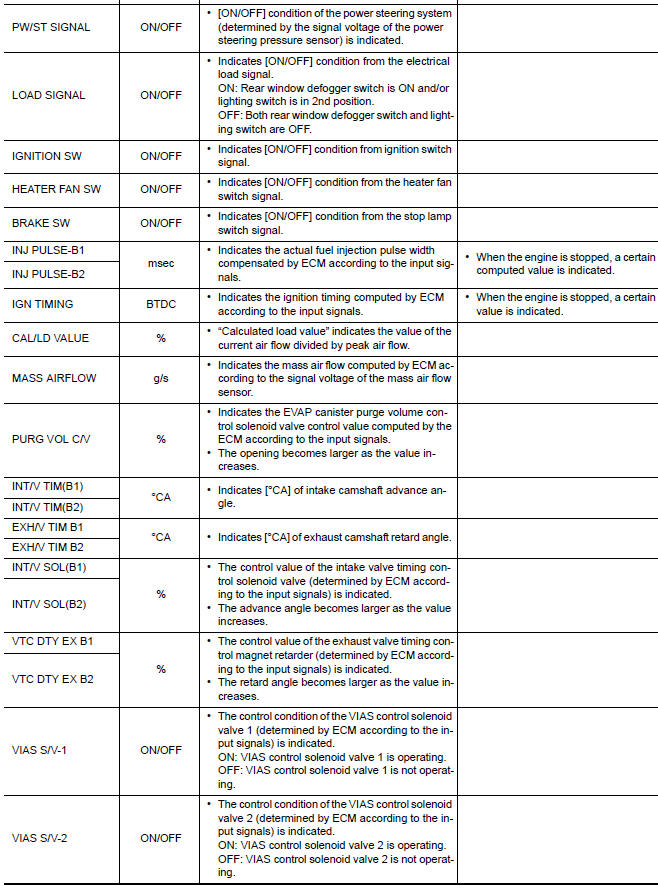
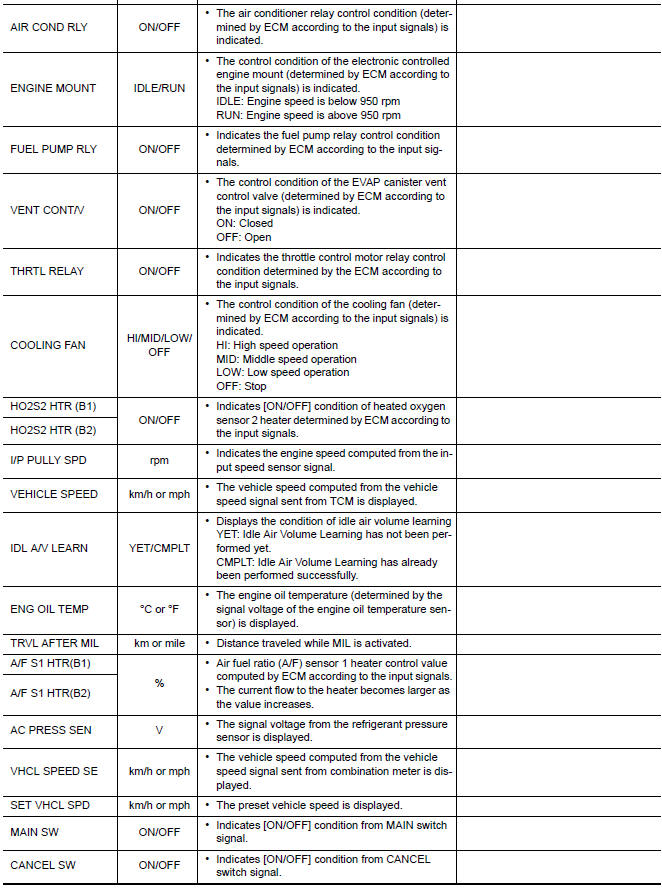
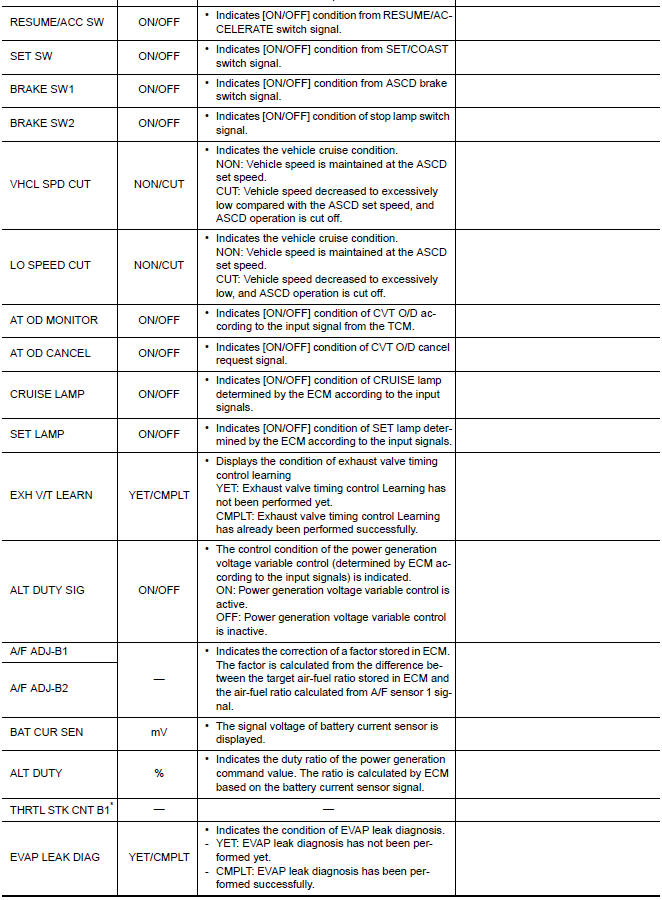
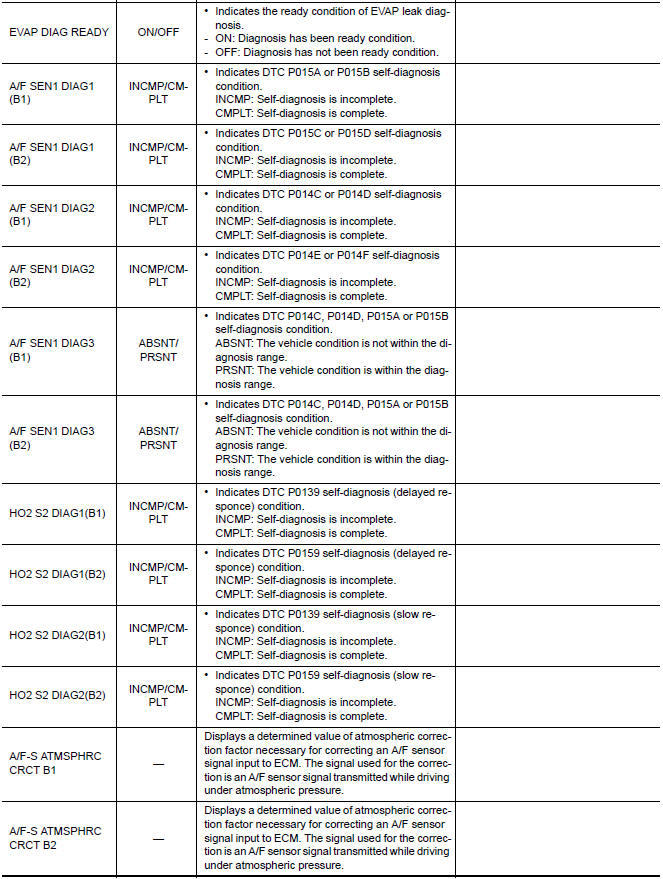

*: The item is indicated, but not used.
NOTE: Any monitored item that does not match the vehicle being diagnosed is deleted from the display automatically.
WORK SUPPORT MODE
Work Item
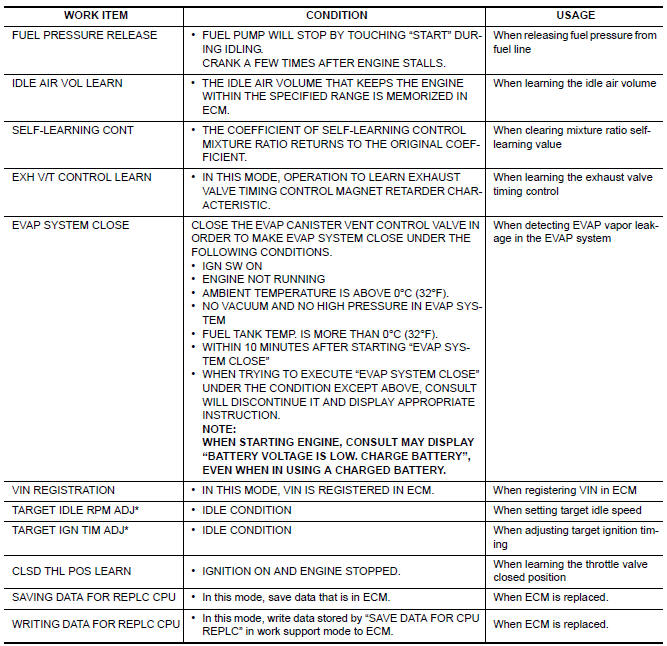
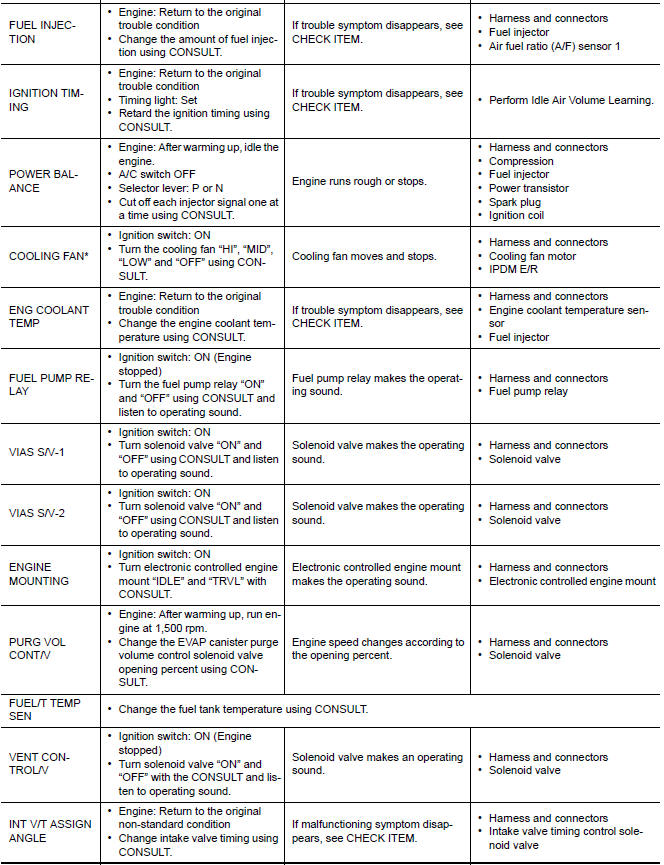

*: Leaving cooling fan OFF with CONSULT while engine is running may cause the engine to overheat.
DTC WORK SUPPORT MODE
Test Item
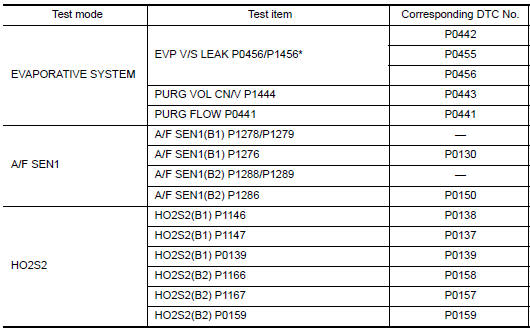
*: DTC P1442 and P1456 does not apply to this model but appears in DTC Work Support Mode screens.
SRT & P-DTC MODE
SRT STATUS Mode
- For items whose SRT codes are set, "CMPLT" is displayed on the CONSULT screen; for items whose SRT codes are not set, "INCMP" is displayed.
- "SRT STATUS" provides the presence or absence of permanent DTCs stored in ECM memory.
PERMANENT DTC STATUS Mode
How to display permanent DTC status
- Turn ignition switch OFF and wait at least 10 seconds.
- Turn ignition switch ON.
- Turn ignition switch OFF and wait at least 10 seconds.
- Turn ignition switch ON.
- Select "PERMANENT DTC STATUS" in "DTC & SRT CONFIRMATION" mode with CONSULT.
NOTE: Permanent DTCs stored in ECM memory are displayed on the CONSULT screen to show if a driving pattern required for erasing permanent DTCs is complete (CMPLT) or incomplete (INCMP).
CAUTION: Since the "PERMANENT DTC STATUS" screen displays the previous trip information, repeat the following twice to update the information: "Ignition switch OFF", "Wait for more than 10 seconds" and "Ignition switch ON".
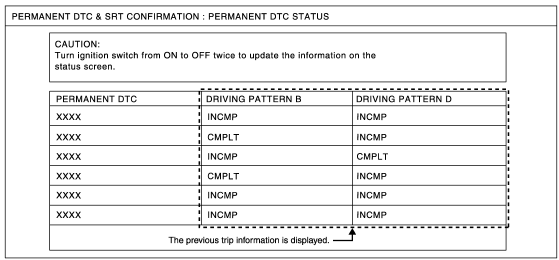
NOTE: This mode is not used in regions that permanent DTCs are not regulated by law.
SRT WORK SUPPORT Mode
This mode enables a technician to drive a vehicle to set the SRT while monitoring the SRT status.
PERMANENT DTC WORK SUPPORT Mode
This mode enables a technician to drive a vehicle to complete the driving pattern that is required for erasing permanent DTC.
NOTE: This mode is not used in regions that permanent DTCs are not regulated by law.
 On board diagnostic (OBD) system
On board diagnostic (OBD) system
Diagnosis Description
This system is an on board diagnostic system that records exhaust
emission-related diagnostic information
and detects a sensors/actuator-related malfunction. A malfunction i ...
Other materials:
U1227 AV control unit
DTC Logic
Diagnosis Procedure
1.CHECK PLAYBACK OF A DISK (DVD)
U1228 AV CONTROL UNIT
DTC Logic
DTC DETECTION LOGIC
U1229 AV CONTROL UNIT
DTC Logic
DTC DETECTION LOGIC
U122A AV CONTROL UNIT
DTC Logic
Diagnosis Procedure
1.PERFORM THE SELF-DIAGNOSIS
When U122A is detected, wri ...
Multiport fuel injection system
System Diagram
System Description
INPUT/OUTPUT SIGNAL CHART
*1: This sensor is not used to control the engine system under normal
conditions.
*2: This signal is sent to the ECM via the CAN communication line.
*3: ECM determines the start signal status by the signals of engine speed ...
ECM branch line circuit
Diagnosis Procedure
1.CHECK CONNECTOR
Turn the ignition switch OFF.
Disconnect the battery cable from the negative
terminal.
Check the following terminals and connectors
for damage, bend and loose connection (unit side and connector
side).
&nb ...
Nissan Maxima Owners Manual
- Illustrated table of contents
- Safety-Seats, seat belts and supplemental restraint system
- Instruments and controls
- Pre-driving checks and adjustments
- Monitor, climate, audio, phone and voice recognition systems
- Starting and driving
- In case of emergency
- Appearance and care
- Do-it-yourself
- Maintenance and schedules
- Technical and consumer information
Nissan Maxima Service and Repair Manual
0.0065

